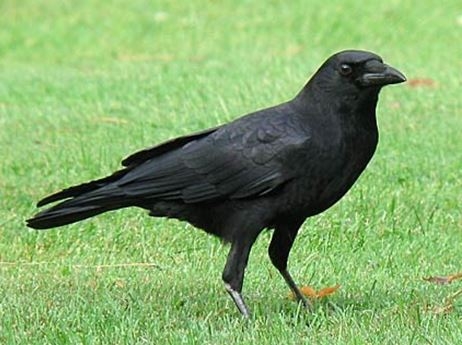Dec 28, 2015
Garden Advice from the Help Desk of the
UC Master Gardeners of Contra Costa County
Description of the client's problem:

American Crow
Advice from the Help Desk:
Crows have become more prevalent in Contra Costa County in the past 15 years, mainly moving in from the decreasing agricultural areas of east County. They are large (17 to 21 inches long) and intelligent birds. Crows are omnivorous, opportunistic feeders that eat a wide assortment of foods, such as grain crops in agricultural fields, seeds and fruits, insects including pest species like lawn grub larvae, bird eggs, earthworms, fish, amphibians, reptiles, carrion and road kill, and a variety of human-associated food, ranging from pet food to garbage.
If they are digging in your lawn, here is a link to information from the University of California on how to control lawn insects: http://www.ucdavis.edu/PMG/PESTNOTES/pn7476.html. Some treatments may not completely take care of the problem and there are other pests, such as raccoons and skunks, that may be causing the damage.
Scare tactics can be effective in dispersing crows. Frightening devices include loud sounds and motion-sensing water sprinklers. In a residential neighborhood you probably want to avoid noise rockets, so the motion-sensing sprinklers are your best bet. These are attached to a hose (one model has its own reservoir) and when it senses motion, it fires off high-pressure water. Some also emit ultrasonic sound but birds don't hear at that frequency so it is probably not helpful. You can do an Internet search for “motion sensing sprinklers” or you may also find them at a local nursery, hardware store or home improvement store.
Farmers have been trying to protect their fields from crows and other birds for centuries. One method is to stretch a cord or a fine wire at intervals across a field at heights about six to eight feet above the ground. Aluminum or cloth strips can also be tied to the wire. The reason why this works is not entirely clear, but the wire appears to represent an obstacle that is difficult for a flying bird to see, especially when rapid escape may be necessary. You might try temporarily stringing lines above your lawn to see if this will deter them. Another website that may be of interest is: http://icwdm.org/handbook/birds/AmericanCrows.asp.
Crows are very intelligent birds and many have become habituated to people and our attempts to discourage them. They have often lost their wariness and, unfortunately, may not respond to any of these suggestions. If you find a new and effective technique, please let us know.
********************************
Editor's Addendum: In reviewing and preparing this blog, I also reviewed a recent web interview at http://awaytogarden.com/the-gifts-of-the-crow-with-john-marzluff/ specifically about crows by the noted ornithologist Dr. John Marzluff, professor of wildlife sciences at the University of Washington. My take-away message from the interview is that you have a formidable and intelligent garden opponent and friend in the crow. I highly recommend the web interview.
********************************
Help Desk of the UC Master Gardeners of Contra Costa County (SEH)
Note: The UC Master Gardeners of Contra Costa's Help Desk is available year-round to answer your gardening questions. Except for a few holidays, we're open every week, Monday through Thursday for walk-ins from 9:00 am to Noon at 75 Santa Barbara Road, 2d Floor, Pleasant Hill, CA 94523. We can also be reached via telephone: (925) 646-6586, email: ccmg@ucanr.edu, or on the web at http://ccmg.ucanr.edu/Ask_Us/ MGCC Blogs can be found at http://ccmg.ucanr.edu/HortCoCo/ You can also subscribe to the Blog (//ucanr.edu/blogs/blogcore/blogroll.cfm).